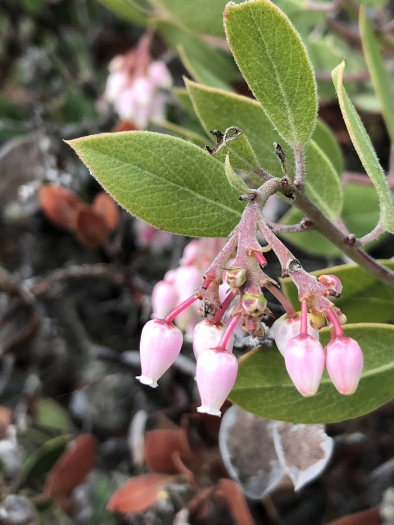Shagbark Manzanita
(Arctostaphylos rudis)
Shagbark Manzanita (Arctostaphylos rudis)
/
/

paulexcoff
CC BY-SA 4.0
Image By:
paulexcoff
Recorded By:
Copyright:
CC BY-SA 4.0
Copyright Notice:
Photo by: paulexcoff | License Type: CC BY-SA 4.0 | License URL: http://creativecommons.org/licenses/by-sa/4.0/ | Rights Holder: paulexcoff | Publisher: iNaturalist | Date Created: 2020-01-25T11:27:27-08:00 |


























































Estimated Native Range
Summary
Arctostaphylos rudis, commonly known as Shagbark Manzanita, is an evergreen shrub native to the coastal sage scrub and chaparral of California, particularly in the Central Coast region. This shrub typically grows from a burl and reaches heights between one and two meters (3 to 6 ft). Its distinctive feature is the shredding gray and reddish bark on the stem and branches, which provides an interesting texture in the garden. The smaller branches are coated in woolly fibers, adding to its unique appearance. The leaves of Arctostaphylos rudis are oval, smooth along the edges with few hairs, green, and shiny, measuring 1 to 3 centimeters in length. The plant is known for its urn-shaped manzanita flowers that bloom in late fall and winter, offering a source of nectar for pollinators during a season when few other plants are in flower. The fruits are hairless red drupes about a centimeter wide, which can attract birds and other wildlife.
Shagbark Manzanita is valued for its drought tolerance and low water requirements, making it an excellent choice for xeriscaping and native plant gardens. It thrives in full sun and requires soils with fast drainage, typically found in its native chaparral habitat. While it is not commonly used for culinary or medicinal purposes, its ornamental value lies in its attractive bark, winter flowers, and wildlife support. Gardeners should note that Arctostaphylos species can be susceptible to root rot if overwatered or planted in poorly draining soils. Additionally, they are adapted to nutrient-poor soils and may not require fertilization.CC BY-SA 4.0
Shagbark Manzanita is valued for its drought tolerance and low water requirements, making it an excellent choice for xeriscaping and native plant gardens. It thrives in full sun and requires soils with fast drainage, typically found in its native chaparral habitat. While it is not commonly used for culinary or medicinal purposes, its ornamental value lies in its attractive bark, winter flowers, and wildlife support. Gardeners should note that Arctostaphylos species can be susceptible to root rot if overwatered or planted in poorly draining soils. Additionally, they are adapted to nutrient-poor soils and may not require fertilization.CC BY-SA 4.0
Plant Description
- Plant Type: Shrub
- Height: 3-6 feet
- Width: 3-6 feet
- Growth Rate: Moderate
- Flower Color: Pink, Green, Red
- Flowering Season: Spring, Winter
- Leaf Retention: Evergreen
Growth Requirements
- Sun: Full Sun
- Water: Very Low
- Drainage: Fast
Common Uses
Bank Stabilization, Bee Garden, Bird Garden, Butterfly Garden, Deer Resistant, Drought Tolerant, Hummingbird Garden, Low Maintenance, Salt Tolerant, Street Planting
Natural Habitat
Coastal sage scrub and chaparral of California, particularly in the Central Coast region
Other Names
Common Names: Sand Mesa Manzanita
Scientific Names: , Arctostaphylos rudis,
GBIF Accepted Name: Arctostaphylos rudis Jeps. & Wiesl.